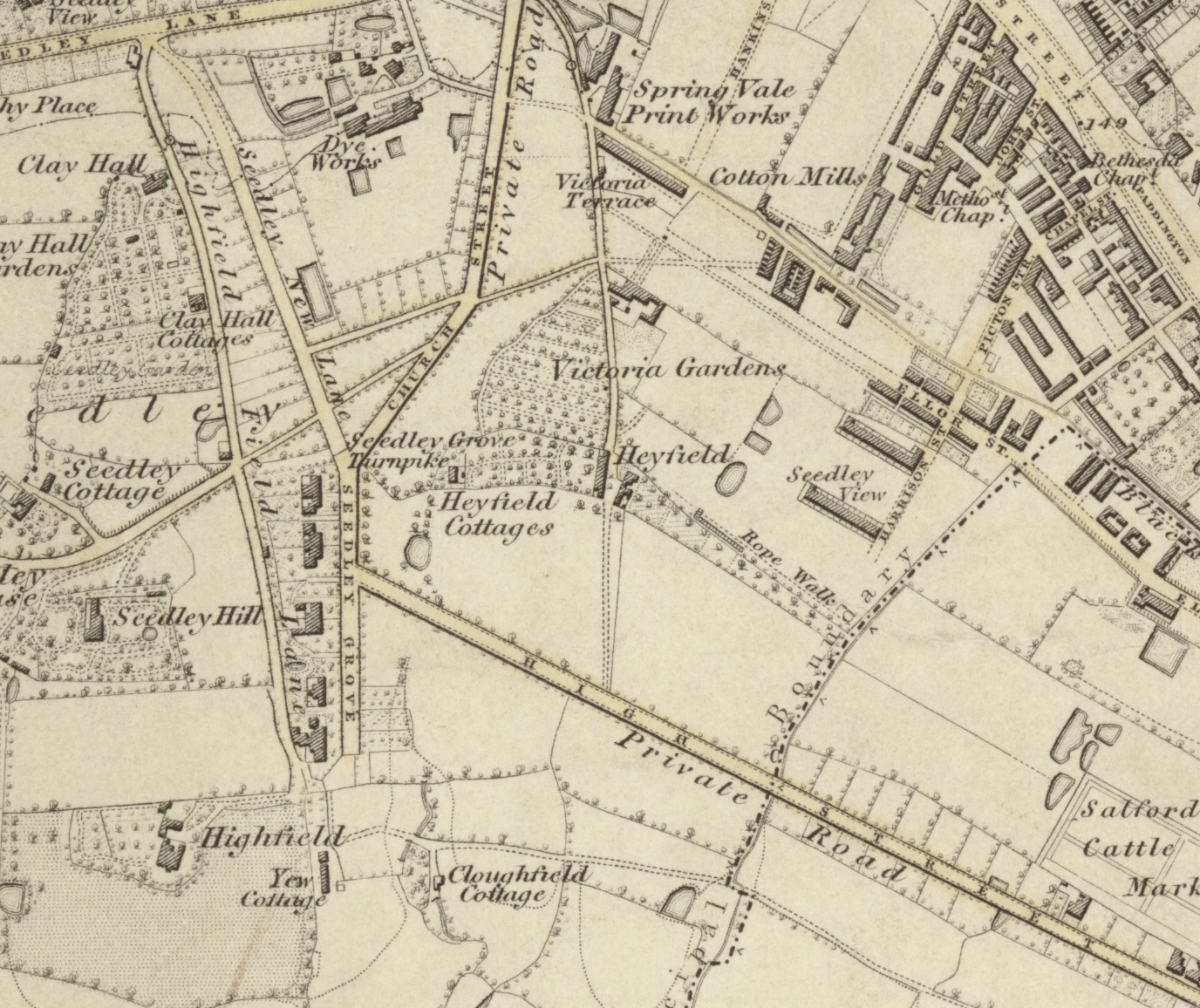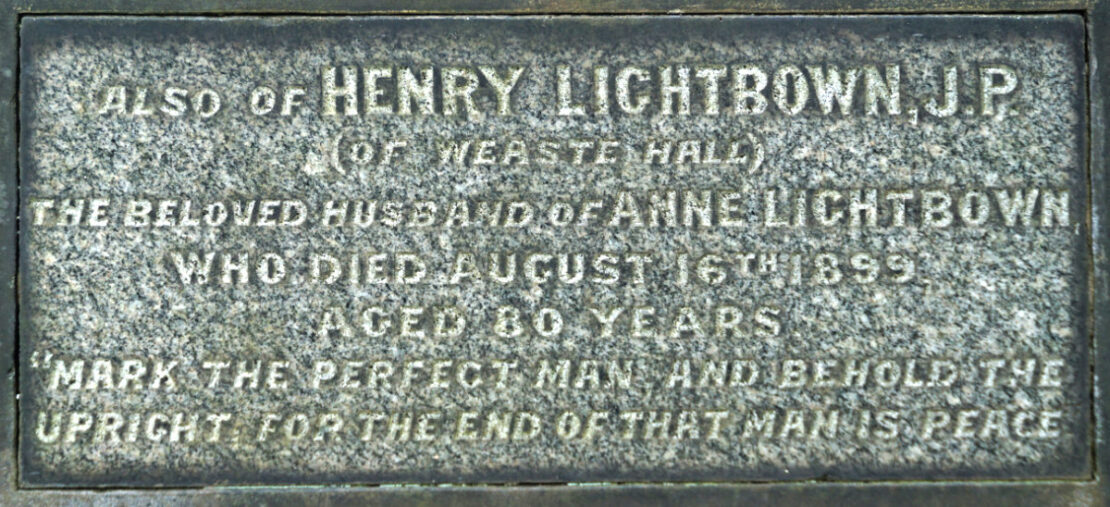Henry Lightbown

Henry Lightbown (1819-1899) was a ‘paper stainer’, Congregationalist, Liberal Unionist, magistrate and Salford councillor. Lighbown was born in a rural hamlet in Lower Darwen the son of John Lightbown and Esther Duckworth. In 1843 he and Anne Aspinall were married in Darwen. After formative years in Darwen and Manchester Lightbown spent most of his life living and working in Pendleton. In the 1850s, with his brother James and brother-in-law William Aspinall, Lightbown established a wall paper factory, Lightbown Aspinall, at the Hayfield Mills, in Pendleton. Lightbown lived nearby at various houses including on Havelock Terrace near Strawberry Road, Vine Grove on Eccles Old Road, 24 Seedley Road, the Willows and Weaste Hall where he died in 1899.
Wall paper manufacturer Henry Lightbown gained early experience as a ‘paper stainer’ at Potter’s wallpaper manufacturers in Darwen, Lancashire, previously working in a cotton mill. In 1847 he left Potters and set up as a wall paper merchant in High Street, Manchester with his brother-in-law William Aspinall and a Dr Graham. As a Manchester merchant Lightbown was able to supplement his technical understanding of the manufacturing process gained at Potters with business “know how’ and an understanding of consumer preferences in this newly emerging industry. Lightbown entered the wall paper industry at a significant time when several developments provided favourable economic advantages. These included the move from hand to machine production and the 1846 reduction in the paper tax, both making wall paper – or paper hangings as they were called at the time – cheaper and therefore within the reach of a wider population. The building boom in the middle of the century, especially the construction of middle and working class terraced housing, also contributed to demand. Seeing this potential, in 1851 Lightbown purchased a small piece of land at Cross Lane, Salford where initially he printed wall papers using wooden blocks, a time consuming and labour intensive process which was soon to be eclipsed by mechanical printing.


In 1854, as the business expanded, Lightbown bought a further 22 acres of farmland from Robert Sugden, a Manchester warehouseman who lived at Hayfield House, Pendleton. Such a large investment reflected Lighbown’s confidence and aspiration. The initial factory was small but eventually the site was covered with numerous buildings dedicated to wall paper manufacture with a workforce of 260 men and boys by 1881. A description of the land had appeared in the newspapers in 1845 which may have been the time when the Hayfield estate was purchased by Robert Sugden.
The Fee-simple and Inheritance of and in all those Nine several Fields and Closes of LAND, situate in the townships of Pendleton and Salford, lying between Cross Lane and Seedley Grove, and known the names of the Top Field, Rushy Field Pit Field, Duke’s Meadow, Bowk-house Field, Half-acre Field, Field-before the door, Nearer-barn Field, and Further-barn Field, and containing 22 acres 2 roods and perches statute measure, or thereabouts. And all those Two Messuages, Cottages Dwelling-houses, and Outbuildings, standing on the said land. There is a bed of clay of excellent quality, for brickmaking, on the land, and stream of very good water flows through it, and its central and rapidly improving situation renders it highly eligible for building purposes. Further particulars may be known on application to Mr. GEORGE E. MARSDEN, solicitor, St. James’s Square, Manchester, where plans of the property may be seen. Manchester Courier and Lancashire General Advertiser – Saturday 21 June 1845


Nineteenth century wall paper technology is intertwined with developments in calico printing. In 1839 the first wallpaper printing machine, based on that used in calico printing, was patented by Potters & Ross, a cotton printing firm based in Darwen, Lancashire. Lightbown soon took advantage of the machine which printed continuous lengths of wall paper using rollers similar to those used in calico printing. By 1851 it was possible to print wall paper with 20 colours although fewer colours were the norm. Lightbown Aspinall newspaper adverts for workmen frequently mention machines of eight rollers and less so we can assume that this was the norm at the Pendleton factory. Continuous rolls of paper meant that large volume production was possible, leading to wall paper becoming cheaper as the century progressed. These developments resulted in wall paper production in Britain rising from one million rolls in 1834 to almost nine million rolls in 1860. Prices dropping to as little as a farthing a yard made wall paper affordable to many. Lightbown himself contributed to the technical development of the wall paper industry achieving several patents including the one below.

In 1890 Lightbown built a new hall and Liberal club at the Hayfield Mills on Percy Street, Pendleton. Known as Lightbown Hall it was demolished in 1965.
The building, which is a handsome one, has been erected from designs by Messrs. E and F. Hewitt, of Albert Square, Manchester, and is intended for the use of the workpeople of the firm of Messrs. Lightbown, Aspinall and CO., with rooms reserved for the use of the Liberal Unionist party. It is built of Accrington stock bricks, with Ruabon terra-cotta facings, the roof being constructed of tiles, with finials and gables of Ruabon terra-cotta. The interior consists of a lecture hall, and billiard, news, and other rooms. The lecture hail, which is on the lower floor, measures 161 square yards. It will be fitted up with pitch pine seats, and will have a raised platform. The billiard room is over the lecture hall and is a spacious apartment. Adjoining the billiard room are reading and cloak rooms. The building is heated throughout with hot water, and is ventilated by means of sun burners, furnished with air shafts, extracting ventilators being placed on the roof. In the basement there are good cellars, with apparatus for making tea. The cost of the building is between £1,300 and £1,400: with the land between £2,000 and £3,000. Mr. Henry Martin, of No. 1, Brindle Heath Road, Pendleton, is the builder; and Messrs. Wilson and Co., of King-street, Manchester, have carried out the heating and ventilating arrangements. It is probable that a portion of the premises will be used by the West Salford Liberal Unionist Association, for which Mr. Lightbown at present provides a room in Highfield Lane, Pendleton. Accommodation will also be provided for meetings for the Salford Liberal Union Club. The new hail will be opened about next September. Manchester Times – Saturday 31 May 1890

Henry Lighlbown died at Weaste Hall, on August 16 1899 aged 80. He was survived by his wife Anne and four of his six daughters. Along with family members some 150 of his workers attended Lightbown’s funeral at the Salford Cemetery, Weaste. Lightbown left property valued at £162,109 from which his wife, Anne received a £250, annuity, an additional £2,000, and the use for life of Weaste Hall including the household effects. On the decease of his wife, daughter Annie was to have the use of Weaste Hall until she should marry. His residuary estate was divided between his children and the children of his deceased daughters and there were legacies to servants.











A major company in the wallpaper industry in the nineteenth century, Lightbown Aspinall continued to flourish into the twentieth century, operating under the Wall Paper Manufacturers conglomerate which was formed shortly after Lightbown’s death in 1899. In 1929 after 75 years in Pendleton Lightbown Aspinall relocated to the new Hayfield mills at Bredbury, Stockport in order to keep pace with production. Many Pendleton workers removed to Bredbury at that time. Lightbown Aspinall legacy wallpapers can be found in the National archives and several museum collections. References to Lightbown Aspinall appear in many design histories, journals and the records of trade and international exhibitions. Alan Sugden, grandson of both Henry Lightbown and Robert Sugden of Hayfield, became a major figure in wall paper manufacturing and was also responsible for several important historical accounts of the industry. A few examples of Lightbown’s wall papers can be seen above. The link to A History of English Wallpaper by Alan V Sugden 1925 below provides further examples. :- https://archive.org/details/historyofenglish00sugd/page/279/mode/2up?q=%28lightbown%29



